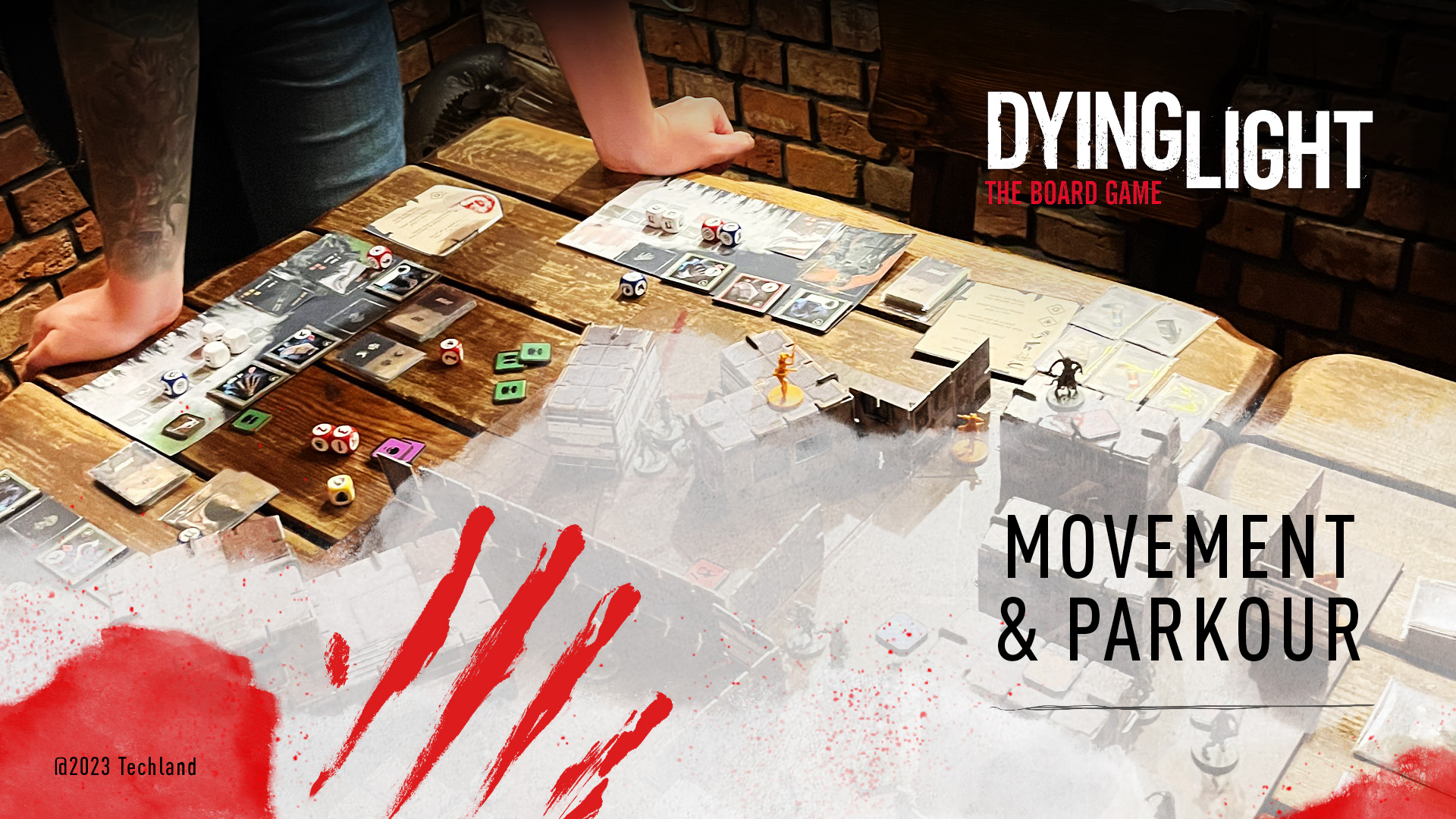Blueprints of the Night
Greetings, Survivors!
Last time, in the first of many of our Survivor’s Logs to come, we presented you with a brief introduction to what we consider to be the core concepts behind the designing process for Dying Light: The Board Game. As you surely recall, we chose to focus on three different yet inextricably linked areas in order to faithfully capture the essence of the game: Parkour & Combat, City Exploration, and the Day/Night paradigm. In today’s article, we’d like to address the latter, which despite being listed last, remains as fundamental as the other two.
The delusion of the day and the terror of the night
There are two faces to the world of Dying Light—that of the Day and that of Night. We strived to deeply root the interdependence between the two not only in the story but also in the gameplay mechanics. But before we spell out the minutiae of our approach, we need to take a closer look at the framework structure of the game itself.
In Dying Light: The Board Game, the players play out single scenarios or entire story-driven campaigns, through taking control of a group of Survivors who struggle to find their footing in the ever-changing micro-world of the vast city of Viledor. Each scenario consists of a series of rounds, during which the players have to complete a set of objectives. The structure of a round itself is very simple and involves two primary phases.
In the first phase, the players take their turns one by one as Runners. At the beginning of their turn the player rolls dice from a pool available to them and performs their actions based on the results (you will get to learn more about dice and actions in our next post!). The key point here is that the level of “danger” involved in taking actions depends on the spot on the tray where each of the dice lands. We refer to this effect as Exposure. The more actions performed, the higher the Exposure. The player will therefore have to decide the amount of actions they wish to perform, taking into account the level of risk involved in each undertaking.
The Exposure system
So what does this whole Exposure thing actually mean? Well, at the stage of simply performing your actions—not a whole lot. Don’t be fooled, though!
The Exposure phase begins once all the players are finished with their turns and represents the stage at which the city gets to respond to the Runners’ actions. The Exposure cards drawn during the previous phase—their number depending on the Exposure level a player reached through the use of their actions—indicate the number of Infected that get to move, the manner in which they do so, as well as their target. They also determine the spawn locations for new Infected, and—if the players allow themselves to be particularly careless—the effects of a Chase potentially initiated by the Runners.
Through controlling enemy behavior, the Exposure system is closely related to player decisions, establishing the flow of events in the game, providing a direct response from the hostiles, and finally introducing an element of risk and a pervading sense of uncertainty.
Well-planned vs. “Well, we’ve panicked!”
The duality described here becomes exceptionally significant when you consider it from the perspective of the changing time of day. Remember how we mentioned that players take their turns in sequence, one after the other? Well, during the day—when the coast is clear and not a single spot seems to be beyond reach—the players can discuss and establish the order of their actions among themselves. Say, one goes scouting, the other decides to search through a potentially hazardous area, while another watches their back. Piece of cake, right? After all, daytime belongs to the Survivors!
At nightfall, however, the rules of the game change drastically. From now on, each player drops their activation token into a small bag and the order in which they take their turns becomes random. Darkness, stress, disorientation, panic—at night you lose the comforts of calculation and free communication. Additionally, there’s a black token in the bag that doesn’t belong to any of the players. You can probably guess what it’s supposed to represent…
This simple but impactful change makes playing scenarios during the day vs. at night two completely different stories. Together with the day/night-sensitive Trauma cards, increased Exposure values for night-time actions, and the Immunity system which counts down the turns left before you turn into a monster, this whole new experience serves to show that the difference between day and night goes well beyond being able to get a tan.

Like night and day
As previously mentioned, the world of Dying Light is twofold in nature.
In the daytime, it is calm and quiet. Tempting with the light of day, deceptive with seemingly harmless groups of Biters roaming the streets. People enjoy what they have and focus on simply trying to survive. They camp on the rooftops, talk, and stay vigilant. But those who have seen enough know better. The problems of this world do not disappear. Survivors lick their wounds and release their traumas behind the closed doors of their improvised shelters. Bandits prey on gullible citizens, setting their own ruthless laws.
There’s terror potentially lurking Inside every abandoned building, and in every place the sun does not reach. There are evil things waiting to emerge once the evening bells begin to toll. Only madmen would dare venture into the Dark Zones during the day, with all sorts of Infected hiding from sunlight. The wise one waits until night falls…
As darkness falls, the world of Dying Light is an entirely different beast. Faster and fiercer varieties of Infected take to the streets. People retreat from the rooftops to wait the night out in their hideouts, flooding themselves in UV. Those who fail to find shelter on time become a feast for the Biters. On the other hand, it is during the night that the treasures of the old world become available to those who dare to reach for them and are bold enough to go out and explore underground structures and parts of the city that are off-limits by day.
There’s a catch, of course—you have to get there in one piece, and safely return with the loot. Many never do, while some of those who make it are never quite the same again. But, returning at dawn, squinting their eyes as they bask in the rising sun, they receive a hero’s welcome.
Daytime provides an illusion of normality. The night, on the other hand, is only for the strong of heart. It defines your survival, drawing you in and dragging you along a path of horror.
That’s the life of a Runner in a nutshell. The manner in which you make sense of the illusion of day and the way you face the terrors of the night is entirely up to you.
Be on the lookout for our next log, in which we turn to the player characters—the Survivors, delineating the ways in which they function in the once beautiful, apocalypse-stricken world of Dying Light.
The night’s still young
That’s it for now—be sure to let us know what you think!
What’s your preference—the careless exploration of the daytime or tension-filled nighttime expeditions to the hot-zone?
Do you imagine yourself gliding between buildings in the morning sun, or rather sneaking around and silently taking down entire bandit camps?
Don’t worry if you haven’t played the video game (which we sincerely encourage you to do!). We’re equally as thrilled to have your input into the implementation of the passage of time in Dying Light: The Board Game.
Is a flat +3 for the bad guys or -2 for the good guys going to do it for you? Or perhaps you envision an entirely different approach to the structure of the game?
Either way, stay tuned & stay human. And don’t go reading this at night and out of a safe zone, cause that’d be downright careless! If you do insist, make sure to have your UV lamp handy and don’t forget to join the discussion at the official Facebook group for Dying Light: The Board Game.




